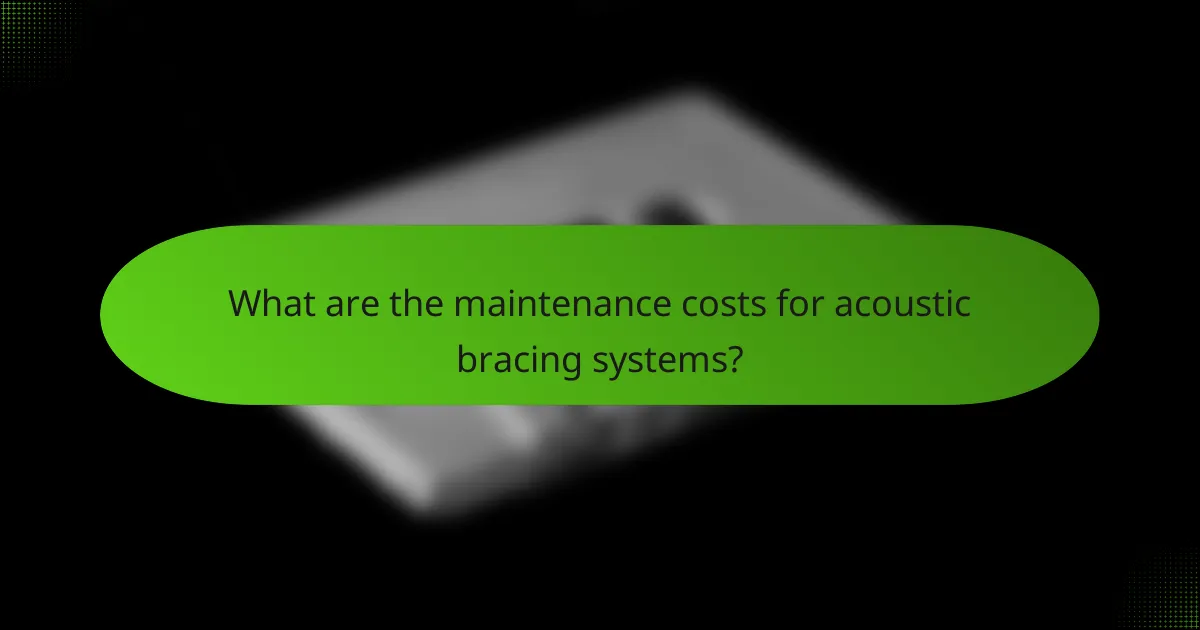When considering acoustic bracing systems for commercial use, it is crucial to understand the various cost factors that can impact budgeting. These include material quality, installation complexity, and specific acoustic performance requirements, which can lead to significant price variations. By evaluating these elements, businesses can make informed decisions that align with their acoustic needs and financial constraints.

What are the cost factors for acoustic bracing systems in commercial buildings?
The cost of acoustic bracing systems in commercial buildings is influenced by several key factors, including material quality, installation complexity, building size, acoustic performance requirements, and local labor rates. Understanding these elements can help businesses budget effectively for their acoustic needs.
Material quality
The quality of materials used in acoustic bracing systems significantly impacts overall costs. Higher-quality materials, such as specialized acoustic panels or resilient channels, tend to be more expensive but offer better sound absorption and durability. Investing in premium materials can lead to long-term savings by reducing the need for replacements or repairs.
When selecting materials, consider the specific acoustic needs of the space. For example, using dense materials can enhance soundproofing but may increase costs. Balancing quality with budget constraints is crucial.
Installation complexity
Installation complexity directly affects labor costs and overall project expenses. Systems that require intricate designs or specialized techniques will typically incur higher installation fees. For instance, custom installations that involve significant modifications to existing structures can be more costly compared to standard setups.
To manage installation costs, consider opting for simpler designs or pre-fabricated solutions where possible. This approach can streamline the installation process and reduce labor hours, ultimately lowering expenses.
Building size
The size of the building plays a critical role in determining the cost of acoustic bracing systems. Larger spaces require more materials and labor, which can significantly increase overall costs. For example, a small office may need only a few panels, while a large auditorium could require hundreds.
When planning for acoustic systems, assess the scale of the project and budget accordingly. Larger projects may benefit from bulk purchasing discounts on materials, which can help mitigate costs.
Acoustic performance requirements
Different environments have varying acoustic performance requirements, which can influence costs. Spaces like recording studios or theaters may demand high-performance systems that are more expensive, while typical office environments may need only basic solutions.
Establish clear acoustic goals early in the planning process. This will help determine the necessary level of investment in acoustic bracing systems and avoid overspending on features that may not be essential for the intended use of the space.
Local labor rates
Local labor rates can vary widely based on geographic location and market conditions, impacting the overall cost of installation. Areas with a high cost of living often have higher labor rates, which can increase project expenses significantly.
To optimize costs, research local labor markets and consider obtaining multiple quotes from contractors. This can help identify competitive pricing and ensure that the project stays within budget while still meeting quality standards.

How do acoustic bracing systems compare in price across different brands?
Acoustic bracing systems vary significantly in price depending on the brand, materials used, and specific features. Generally, prices can range from a few hundred to several thousand dollars, making it essential to compare options based on quality and performance.
GIK Acoustics pricing
GIK Acoustics offers a range of acoustic bracing systems, typically priced between $200 and $1,500. Their products are known for high-quality materials and effective sound absorption, making them a popular choice for commercial spaces. Consider their bass traps and panels, which provide good value for performance.
When selecting GIK products, evaluate the specific needs of your space, as their solutions can be tailored for different acoustic challenges. Look for package deals that may offer savings on bulk purchases.
Auralex Acoustics pricing
Auralex Acoustics features a variety of acoustic bracing systems, with prices generally ranging from $150 to $1,200. Their products are widely used in professional studios and commercial environments due to their effectiveness in sound control. Auralex’s Studiofoam panels are particularly popular for their versatility and ease of installation.
For best results, assess the acoustic requirements of your environment and choose Auralex products that match those needs. They often provide installation guides that can help maximize performance without excessive costs.
Primacoustic pricing
Primacoustic’s acoustic bracing systems are priced between $300 and $2,000, depending on the complexity and size of the installation. Their products are designed for both aesthetic appeal and acoustic performance, making them suitable for various commercial applications. Primacoustic’s Broadway panels are a notable option for enhancing sound quality while maintaining a professional look.
When considering Primacoustic, factor in the long-term benefits of improved acoustics against the initial investment. Their products often come with warranties, which can add to their overall value.

What are the installation costs associated with acoustic bracing systems?
The installation costs for acoustic bracing systems can vary significantly based on factors such as the complexity of the project and whether professionals or DIY methods are used. Typically, these costs can range from a few hundred to several thousand dollars, depending on the specific requirements and materials involved.
Professional installation fees
Hiring professionals for the installation of acoustic bracing systems usually incurs higher costs due to labor and expertise. On average, professional fees can range from $50 to $150 per hour, with total project costs often falling between $1,000 and $5,000. Factors influencing these costs include the size of the area, the type of materials used, and local labor rates.
It’s essential to obtain multiple quotes from licensed contractors to ensure competitive pricing. Additionally, check for any warranties or guarantees on the installation work, as these can add value to the overall investment.
DIY installation savings
Opting for a DIY approach can significantly reduce installation costs for acoustic bracing systems. By handling the installation yourself, you can save on labor fees, potentially lowering total expenses to a few hundred dollars for materials alone. However, this requires a good understanding of the installation process and access to the necessary tools.
Before starting a DIY project, consider researching installation guides or watching tutorial videos to familiarize yourself with the steps involved. Be cautious of common pitfalls, such as improper measurements or inadequate material selection, which can lead to additional costs down the line.

What are the long-term cost benefits of investing in acoustic bracing systems?
Investing in acoustic bracing systems can lead to significant long-term cost benefits by enhancing energy efficiency and reducing noise complaints. These systems not only improve the acoustic environment but also contribute to lower operational costs over time.
Energy efficiency improvements
Acoustic bracing systems can enhance energy efficiency by providing better insulation and reducing the need for heating and cooling. By minimizing sound transmission, these systems help maintain a stable indoor climate, which can lead to lower energy bills.
For instance, buildings equipped with effective acoustic bracing may see energy savings of around 10-20% compared to those without. This reduction can translate into substantial savings, especially in larger commercial spaces where energy costs are a significant portion of the budget.
Reduced noise complaints
Implementing acoustic bracing systems can significantly decrease noise complaints from tenants and employees. A quieter environment not only enhances comfort but also boosts productivity, leading to better overall performance in commercial settings.
By addressing noise issues proactively, businesses can avoid potential costs associated with tenant turnover or employee dissatisfaction. Additionally, maintaining a peaceful atmosphere can improve client relations, ultimately benefiting the bottom line.

What financing options are available for commercial acoustic bracing systems?
Several financing options exist for commercial acoustic bracing systems, including leasing arrangements and government grants. These options can help businesses manage upfront costs while ensuring compliance with acoustic regulations.
Leasing options
Leasing is a popular financing method for commercial acoustic bracing systems, allowing businesses to use equipment without a large initial investment. Typically, lease terms can range from one to five years, with monthly payments that can be more manageable than outright purchases.
When considering leasing, evaluate the total cost of the lease versus the purchase price. Some leases may include maintenance and support, which can reduce long-term expenses. Always read the fine print to understand any fees or penalties associated with early termination.
Government grants and incentives
Government grants and incentives can significantly offset the costs of installing acoustic bracing systems. Many local and national programs offer financial assistance for projects that improve energy efficiency or meet specific environmental standards.
To access these funds, businesses should research available grants in their region, as eligibility criteria and application processes can vary. It’s advisable to consult with a financial advisor or grant specialist to navigate the application process effectively and maximize potential funding opportunities.

What are the maintenance costs for acoustic bracing systems?
The maintenance costs for acoustic bracing systems can vary significantly based on factors such as the system’s complexity, usage frequency, and environmental conditions. Regular upkeep is essential to ensure optimal performance and longevity, which can involve inspections, repairs, and potential replacements.
Regular inspections
Regular inspections are crucial for maintaining acoustic bracing systems. These inspections typically occur annually or biannually, depending on the system’s usage and environmental factors. The cost for these inspections can range from a few hundred to several thousand dollars, depending on the complexity of the system and the rates of the service provider.
During inspections, technicians assess the integrity of the bracing components, checking for wear and tear, and ensuring that the system meets relevant safety standards. Prompt identification of issues can prevent more costly repairs down the line.
Repair costs
Repair costs for acoustic bracing systems can vary widely based on the nature of the damage and the components involved. Minor repairs, such as tightening loose brackets or replacing small parts, may cost a few hundred dollars, while major repairs could reach into the thousands, especially if structural elements need replacement.
It’s advisable to budget for potential repairs as part of the overall maintenance plan. Setting aside a percentage of the initial installation cost annually can help manage unexpected expenses effectively. Additionally, consider working with a reliable contractor who can provide ongoing support and maintenance services to minimize long-term costs.

